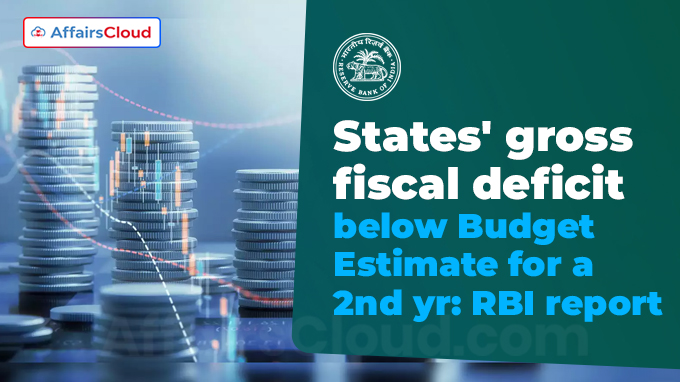
On 11th December 2023, the Reserve Bank of India (RBI) released its annual report titled “State Finances: A Study of Budgets of 2023-24” under the theme “Revenue Dynamics and Fiscal Capacity of Indian States”.
- The report states that the improvement achieved in State finances in 2021-22 was sustained in 2022-23, with the combined States’ gross fiscal deficit (GFD) stood at 2.8% of gross domestic product (GDP).
- This was below the budget estimate of 3.2% and Central Government’s limit of 4% for the second consecutive year due to a reduction in the revenue deficit.
About State Finances: A Study of Budgets of 2023-24:
i.The report provides data on and analysis of the fiscal position of State governments in India during 2021-22 (FY22-Actuals), 2022-23 (FY23-revised estimates/provisional accounts) and 2023-24 (FY24-Budget Estimates).
ii.It was prepared in the Division of State Finances (DSF) in the Department of Economic and Policy Research (DEPR), RBI under the supervision of Muneesh Kapur, Executive Director, RBI.
Key Figures:
i.In FY24, states plan to maintain prudent fiscal management, with a budgeted consolidated GFD at 3.1% of GDP, below the Central Government’s 3.5% limit.
ii.The capital outlay is set to increase by 42.6% in FY24 to 2.9% of GDP.
iii.States target to reduce total outstanding liabilities to 27.6% of GDP in FY24 from the peak of 31.0% in 2020-21, though many states may still exceed 30% of Gross State Domestic Product (GSDP).
iv.The growth in State’s tax revenue during first half of FY24 (H1FY24) is at 14.6% which is marginally lower than the budgeted 17.9%.
v.The growth in the State’s revenue expenditure during H1FY24 is at 8.9% which is much lower than the FY24 budget estimate of 18%.
vi.The Gross Market Borrowings of States/Union Territories (UTs) increased by 8.1% to Rs 7.58 lakh crore during FY23 from Rs 7.02 lakh crore in FY22.
vii.The Net Market Borrowings of States increased by 5.4% to Rs 5.19 lakh crore in FY23 from Rs 4.92 lakh crore in FY22.
- This increase was concentrated in a few States like Andhra Pradesh (AP), Gujarat, Himachal Pradesh (HP), Madhya Pradesh (MP), Haryana and Assam.
Highlights:
i.During H1FY24, states experienced Year-on-Year (Y-o-Y) increase in consolidated GFDs, driven by, lower growth in revenue receipts and higher capital expenditure.
ii.Within revenue receipts, Tax and non-tax revenues slowed, grants contracted due to cessation of GST (Gross and Service Tax) compensation cess, but State goods and services tax (SGST) showed robust growth of 19.7% driven by improved GST compliance and economic activity.
iii.Capital outlay already surged by 52.6% in H1FY24, supported by Central Government’s schemes for Special Assistance to States for Capital Investment.
iv.Fiscal outlook is positive for states in FY24 with adequate fiscal space for higher capital expenditure due to resilient domestic economic activity and consolidation efforts.
- It is expected that there will be improved tax revenue in H2FY24.
Key Points:
i.GST implementation has boosted tax buoyancy for the States.
ii.To enhance tax revenues, states need to strengthen their tax capacity with reforms and innovative administration.
iii.Non-tax revenues can be increased through revising charges on services like electricity and water, mining royalties, and better financial management of Public Sector Undertakings (PSUs).
What is Fiscal capacity?
Fiscal capacity is the revenue a government can actually generate from taxes and other sources. It determines the government’s ability to fund public goods, infrastructure, and economic development while maintaining fiscal discipline and stability.
Recent Related News:
i.RBI has granted permission to non-banking financial companies(NFBCs) categorized as middle layer and base-layer entities to use credit risk mitigation tools. This enables them to offset their exposure (protect themselves from financial risk) using eligible credit risk transfer instruments.
ii.RBI will apply strict supervisory norms under the Prompt Corrective Action (PCA) Framework to government-owned Non-Banking Financial Companies (NBFCs) starting from October 2024. This move has significant implications for these government-owned NBFCs.
About Reserve Bank of India (RBI):
Governor – Shaktikanta Das
Deputy Governors – Swaminathan Janakiraman, Michael Debabrata Patra, M. Rajeshwar Rao, T. Rabi Sankar
Establishment – 1st April 1935
Headquarters – Mumbai, Maharashtra